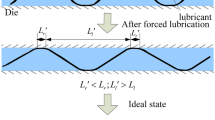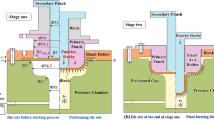Abstract
Micro deep drawing of cylinder cups is a reliable mass production and low cost process if the forming parameters are reasonably chosen. Micro cups with a drawing blank diameter of 2 mm were formed and the effects of lubrication conditions on micro deep drawing were studied. The specimen material was copper alloy Cu-FRHC with a thickness of 40 μm which was thermally treated at 873 K for 12 h in nitrogen atmosphere. The experiments were carried out at room temperature on a universal testing machine without lubrication and under the lubrication of polyethylene (PE) film, soybean oil, and castor oil at a drawing velocity of 0.1 mm/s. The results showed that the micro cups were formed accurately with a minimum diameter of 0.9 mm. The PE film which results in the minimum drawing force, maximum limit drawing ratio (LDR), and good surface quality was better than other lubrication conditions and can be chosen as a proper lubricant in micro forming.










Similar content being viewed by others
References
Engel U (2006) Tribology in microforming. Wear 260:265–273
Engel U, Eckstein R (2002) Microforming-from basic research to its realization. J Mater Process Technol 125–126:35–44
Erhardt R, Schepp F, Schmoeckel D (1999) Micro forming with local part heating by laser irradiation in transparent tools. In: Proceedings of the 7th international conference on sheet metal, pp 497–504
Guo B, Gong F, Wang CJ, Shan DB (2009) Flow stress and tribology size effects in scaled down cylinder compression. Trans Nonferr Met Soc China 19:s516–s520
Hu SG, Chen HZ (2004) Engineering analysis of sheet metal cold forming, 1st edn. Beijing University of Aeronautics and Astronautics Press, China, p 121
Jeswiet J, Geiger M, Engel U, Kleiner M, Schikorra M, Duflou J, Neugebauer R, Bariani P, Bruschi S (2008) Metal forming progress since 2000. J Manuf Sci Technol CIRP 1:2–17
Justinger H, Hirt G, Witulski N (2005) Analysis of cup geometry and temperature condition in the miniaturized deep drawing process. In: Proceedings of the 8th ICTP, CD-ROM
Kataoka S, Murkawa M, Aizawa T, Ike H (2004) Tribology of dry deep-drawing of various metal sheets with use of ceramics tools. Surf Coat Technol 78:582–590
Messner A, Engel U, Kals R, Vollertsen F (1994) Size effect in the FE-simulation of micro-forming process. J Mater Process Technol 45:371–376
Saotome Y, Yasuda K, Kaga H (2001) Microdeep drawability of very thin sheet steels. J Mater Process Technol 113:641–647
Shan DB, Guo B, Zhou J (2007) Development in micro forming of thin metal sheet. J Plast Eng 14:93–99
Sobis T, Engel U, Geiger M (1992) A theoretical study of wear simulation in metal forming processes. J Mater Process Technol 34:233–240
Tiesler N, Engel U, Geiger M (1999) Forming of microparts-effects of miniaturization on friction. In: Proceedings of the 6th ICTP, pp 889–894
Vollertsen F, Hu Z, Niehoff HS, Theiler C (2004) State of the art in micro forming and investigations into micro deep drawing. J Mater Process Technol 151:70–79
Acknowledgments
The authors gratefully acknowledge the financial support of the National Science Foundation of China (No. 50835002 and No. 50805035).
Author information
Authors and Affiliations
Corresponding author
Rights and permissions
About this article
Cite this article
Gong, F., Guo, B., Wang, C.J. et al. Effects of lubrication conditions on micro deep drawing. Microsyst Technol 16, 1741–1747 (2010). https://doi.org/10.1007/s00542-010-1108-7
Received:
Accepted:
Published:
Issue Date:
DOI: https://doi.org/10.1007/s00542-010-1108-7




